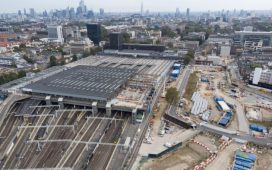Unlock the Editor’s Digest for free
Roula Khalaf, Editor of the FT, selects her favourite stories in this weekly newsletter.
Tenants who buy their own council home through Britain’s “Right to Buy” programme would see the discounts slashed to a fraction of the current rate under plans being drawn up by the Labour party.
Under the scheme, tenants in a council-owned property can buy it at a discount of up to 70 per cent of its market value, depending on the length of time they have lived there, up to a maximum of £96,000 in most of England and £127, 900 in London.
But the system gives social tenants an incentive to buy their property then “flip” it at a profit and it has been blamed for the loss of social housing in the UK.
Matthew Pennycook, shadow housing minister, said that if Labour were to win next year’s election — it is currently around 18 points ahead in the polls — it was likely to return the discounts to the level at which they stood before they were raised by Conservative ministers more than a decade ago.
“We are going to slash the discounts,” he said in an interview with the Financial Times. “They’d get the discounts they got in 2012.”
Britain has seen the waiting lists for social housing swell and the average age of first-time buyers rise to 33 as the country confronts a shortage of residential property. Both Labour and the ruling Conservatives have pledged to build 1.5mn new homes over five years.
Right to buy was first introduced during the 1980s premiership of Margaret Thatcher and transformed a generation of former tenants into homeowners, boosting the popularity of the Conservative party.
In an attempt to revive the scheme a decade ago, former Tory prime minister David Cameron lifted the maximum discount, which had previously ranged from around £16,000 to £38,000.
More than 2mn homes have been bought through the scheme but it has been blamed for a loss of social housing stock as sales outstripped the construction of new units. According to housing charity Shelter, in 2022 there were 1.5mn fewer households in England living in social homes than in 1980.
“We don’t agree with what we’ve seen since 2012, when they increased the discount on right to buy massively and now you have lots of people negotiating deals with private landlords, selling off properties and renting them back to the local authority and we are all paying housing benefit on it,” said Pennycook.
He added that as well as reducing the discounts, a Labour government would increase the length of time new tenants in social housing would have to wait until they had the right to take part in the scheme.
“We think on principle that if you’re a long-term tenant who has been in the property for 30 years or whatever, you should have the right to buy at a reasonable discount,” he said.
In an effort to boost housing supply, the Conservatives have since 2019 aimed to build 300,000 new homes each year but have repeatedly failed to hit their target, with ministers softening planning rules in recent months after a rebellion by backbench Tory MPs.
Pennycook said that a Labour government would liberalise planning, reinstating building targets for local authorities and releasing “lower-quality greenbelt land” for construction of housing. It would also give priority to local residents for off-plan new-builds.
He added that the party would increase the surcharge on stamp duty paid by non-residents on UK property from 2 per cent to 3 per cent, raising £25mn a year. Pennycook said this would be given to local authorities to hire 300 new planners, bolstering council planning functions, which have been hollowed out by public spending cuts.
As part of the party’s plan to increase the housing supply, Labour leader Sir Keir Starmer promised at Labour’s annual conference to deliver a fresh generation of “new towns”.
Pennycook explained that this would include extensions to existing towns: “It’s whatever works for each place,” he said. “The mechanism by which we want to select these areas is for the secretary of state to put a task force together on day one of a Labour government to report back within six months.”
The party is also looking to change the national planning policy framework to enforce tough planning targets for councils. “There’s been no appetite at all on the part of this government to actually do what it takes to ensure that the rates [of building] go up,” Pennycook said.
In an effort to reduce home-building costs in England, Labour is also looking to reform how land is valued when it is acquired by councils through compulsory purchase orders, forcing landowners to sell plots for a fraction of their potential market price.
Pennycook said the party would also give local authorities the power to lift council tax on second homes to 300 per cent of the usual levy, following a similar move in Wales and building on the 200 per cent threshold recently imposed by levelling up secretary Michael Gove.
Pennycook added that he wanted to give local communities the ability to tackle “excessive concentrations” of second homes or holiday lets to help revive the economic health of those areas.
“It might be a licensing scheme works, it might be planning powers, might be council tax provisions,” he said.
“We are talking about areas where they have an excessive concentration of second homes and can’t sustain schools, public services, the village post office. And there are in particular lots of coastal communities, some rural communities, where what is happening is a real crisis.”











